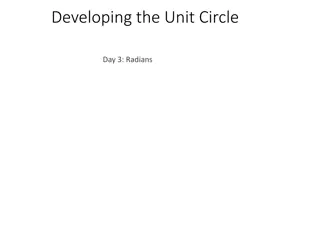
Multistage Amplifiers for Enhanced Voltage Gain
Discover the concept of multistage amplifiers and how cascading multiple amplifier stages can increase overall voltage gain. Learn about different coupling methods and the importance of designing each stage for optimal performance.
Download Presentation

Please find below an Image/Link to download the presentation.
The content on the website is provided AS IS for your information and personal use only. It may not be sold, licensed, or shared on other websites without obtaining consent from the author. If you encounter any issues during the download, it is possible that the publisher has removed the file from their server.
You are allowed to download the files provided on this website for personal or commercial use, subject to the condition that they are used lawfully. All files are the property of their respective owners.
The content on the website is provided AS IS for your information and personal use only. It may not be sold, licensed, or shared on other websites without obtaining consent from the author.
E N D
Presentation Transcript
To increases the voltage gain of the amplifier, multiple amplifier are connected in cascade. The output of one amplifier is the input to another stage. In this way the overall voltage gain can be increased, when number of amplifier stages are used in succession it is called a multistage amplifier or cascade amplifier. The load on the first amplifier is the input resistance of the second amplifier. The various stages need not have the same voltage and current gain. In practice, the earlier stages are often voltage amplifiers and the last one or two stages are power amplifiers. The voltage amplifier stages assure that the power stages have the proper input swing. The amount of gain in a stage is determined by the load on the amplifier stage, which is governed by the input resistance to the next stage. Therefore, in designing or analysing multistage amplifier, we start at the output and proceed toward theinput.
The overall voltage gain is the productof the voltage gain of eachstage. A = A1 A2 An.
To represent the gain of the cascade amplifier, the voltage gain is represented in dB. The two power levels of input and output of an amplifier are compared on a logarithmic scale rather than linear scale. The number of bels by which the output power P2exceeds the input power P1is definedas
Because of dB scale the gain can be directly added when a number ofstages are cascaded.
The three couplings generally usedare. RC coupling Transformercoupling Direct Coupling
RC coupling the most commonly used method of coupling from one stage to the next. An ac source with a source resistance Rs drives the input of an amplifier. The grounded emitter stage amplifies the signal, which is then coupled to next CE stage the signal is further amplified to get largeroutput. In this case the signal developed across the collector resistor of each stage is coupled into the base of the next stage. The cascaded stages amplify the signal and the overall gain equals the product of the individual gains.
The coupling capacitors pass ac but block dc Because of this the stages are isolated as for as dc is concerned. This is necessary to avoid shifting of Q-points. The drawback of this approach is the lower frequency limitimposed by the couplingcapacitor. The bypass capacitors are needed because they bypass the emitters to ground. Without them, the voltage gain of each stage would be lost. These bypass capacitors also place a lower limit on the frequency response. As the frequency keeps decreasing, a point is reached at which capacitors no shorts. At this frequency the voltage gain because of the local feedback and the overall gain of the amplifier drops significantly. These amplifiers are suitable for frequencies above 10 Hz. longer look like a.c. starts to decrease
The frequency response of RC amplifier provides constant gain over a wide frequencyrange,hence most suitable foraudioapplications. The circuit is simple and has lower cost because it employs resistors and capacitors which are cheap. Disadvantages of RC CoupledAmplifier: The voltage and power gain are low because of the effective loadresistance. They become noisy withage. Due to poor impedance matching, power transfer will below. Applications of RC Coupled Amplifier They have excellent audio fidelity over a wide range of frequency. Widely used as Voltageamplifiers Due to poor impedance matching, RC coupling is rarely used in thefinal stages. It becomes more compact with the upgradingtechnology.
We have observed that the main drawback of RC coupled amplifier is that the effective reduced. This is because, the input impedance of an amplifier is low,while its output impedance ishigh. When they are coupled to make a multistage amplifier, the high output impedance of one stage comes in parallel with the low input impedance of next stage. Hence, effective load resistance is decreased. This problem can be overcome by a transformer coupledamplifier. In a transformer-coupled amplifier, the amplifier are coupled using atransformer. load resistance gets stages of
The amplifier circuit in which, the previous stage is connected to the next stage using a coupling transformer, is called as Transformer coupledamplifier. The coupling transformer T1is used to feed the output of 2nd 1ststage to the input of replaced by the primary winding of the transformer. The secondary winding is connected between the potential divider and the base of 2ndstage, which provides the input to the 2ndstage. Instead of coupling capacitor like in RC coupled amplifier, a transformer is used for coupling any two stages, in the transformer coupled amplifiercircuit. stage. The collector load is
The potential divider network R1and R2and the resistor Re together form the biasing and stabilization network. The capacitor Ceoffers a low reactance path to signal. The resistor RLis used as a load impedance. The input capacitor Cinpresent at the initial stage of the amplifier couples AC signal to the base of the transistor. The capacitor CCis the coupling capacitor that connects two stages and interference between the stages and controls the shift of operatingpoint. emitter by-pass the prevents DC
When an AC signal is applied to the input of the base of the first transistor then it gets amplified by the transistor and appears at the collector to which the primary of the transformer is connected. The transformer which is used as a coupling device in this circuit has the property of impedance changing, which means the low resistance of a stage (or load) can be reflected as a high load resistance to the previous stage. Hence the voltage at the primary is transferred according to the turns ratio of the secondary winding of thetransformer. This transformer coupling matching between the stages of amplifier. The transformer coupled amplifier is generally used for power amplification. provides good impedance
The gain of the amplifier is constant only for a small range of frequencies. The output voltage is equal to the collector current multiplied by the reactance ofprimary. At low frequencies, the reactance of primary begins to fall, resulting in decreased gain. At high frequencies, capacitance between turns of windings acts as a bypass condenserto reduce theoutput voltage and hence gain. So, the amplification of audio signals will not be proportionate and some distortion will also get introduced, which is called as Frequency distortion. the
Advantages An excellent impedance matching isprovided. Gain achieved is higher. There will be no power loss in collector and baseresistors. Efficient inoperation. Disadvantages Though the gain is high, it varies considerably with frequency. Hence a poor frequencyresponse. Frequency distortion ishigher. Transformers tend to produce humnoise. Transformers are bulky and costly. Applications Mostly used for impedance matchingpurposes. Used for Poweramplification. Used in applications where maximum powertransfer is needed.
As no coupling devices are used, the coupling of the amplifier stages is done directly and hence called as Direct coupled amplifier. Especially used to amplify lower frequencies, such as amplifying photo-electric current or thermo-couple current or so.
The figure below indicates the three stage direct coupled transistor amplifier. The output of first stage transistorT1 is connectedtothe inputof secondstagetransistorT2.
The transistor in the first stage will be an NPN transistor, while the transistor in the next stage will be a PNP transistor and so on. This is because, the variations in one transistor tend to cancel the variations in the other. The rise in the collector current and the variation in of one transistor gets cancelled by the decrease in the other.
The input signal when applied at the base of transistor T1, it gets transistor action and the amplified output appears at the collector resistor Rcof transistor T1. This output is applied to the base of transistor T2which further amplifies the signal. In this way, a signal is amplified in a direct coupled amplifier circuit. amplified due to the
Advantages The circuit arrangement is simple because of minimum use of resistors. The circuit is of low cost because of the absence of expensive couplingdevices. Disadvantages It cannot be used for amplifying high frequencies. The operating point is shifted due to temperaturevariations. Applications Low frequency amplifications. Low current amplifications.
UNIT-2 Large Signal Amplifier
After the audio signal is converted into electrical signal, it has several voltage amplifications done, after which the power amplification of the amplified signal is done just before the loud speaker stage. This is clearly shown in the belowfigure.
While the voltage amplifier raises the voltage level of the signal, the power amplifier raises the power level of the signal. Besides raising the power level, it can also be said that a power amplifier is a device which converts DC power to AC power and whose action is controlled by the input signal. The DC power is distributed according to the relation, DC power input = AC power output + losses
The voltage gain of an amplifier is givenby : Av= (Rc/Rin) The characteristicsof a voltageamplifier areas follows: The base of the transistor should be thin and hence the value of should be greater than100. The resistance of the input resistor Rinshould be low compared to collector loadRC. when The collector load RCshould be relatively high. To permit collector load, the voltage amplifiers are always operated at low collectorcurrent. high The voltage amplifiers are used for small signalvoltages.
It is larger in size, in order to handle large powers. The collector region of the transistor is made large and a heat sink is placed at the collector-base junction in order to minimize heat generated. The emitter and base regions of a power transistor are heavily doped. Due to the low input resistance, it requires low inputpower.
S.No Particular Voltage Amplifier High (>100) Power Amplifier Low (5 to 20) 1 2 RC High (4-10 K ) Low (5 to 20 ) Invariably transformer coupling Usually R-C coupling 3 Coupling 4 Input voltage Low (a few m V) High (2-4 V) 5 Collector current Low ( 1 mA) High (> 100 mA) 6 Power output Low High 7 Output impendence High ( 12 K ) Low (200 )
Class A Power amplifier When the collector current flows at all times during the full cycle of signal, the power amplifier is known as class A poweramplifier. Class B Power amplifier When the collector current flows only during the positive half cycle of the input signal, the amplifier is known as class B poweramplifier. Class C Power amplifier When the collector current flows for less than half cycle of the input signal, the power amplifier is known as class C poweramplifier. Class AB amplifier - if we combine the class A and class B amplifiersso as to utilize the advantages of both. power
A Class A power amplifier is one in which the output current flows for the entire cycle of the AC input supply. Hence the complete signal present at the input is amplified at the output.
The operating point of this amplifier is present in the linear region. It is so selected that the current flows for the entire ac input cycle. The below figure explains the selection of operating point. The output characteristics with operating point Q is shown in the figure above. Here (Ic)Qand represent no signal collector current and voltage collector and emitter respectively. When signal is applied, the Q-point shifts to Q1and Q2. The output current increases to (Ic)maxand decreases to (Ic)min. Similarly, the collector-emitter voltage increases to (Vce)maxand decreases to (Vce)min. (Vce)Q between
Advantages of Class AAmplifiers The current flows for complete inputcycle It can amplify small signals The output is same asinput No distortion ispresent Disadvantages of Class AAmplifiers Low power output Low collectorefficiency
When the collector current flows only during the positive half cycle of the input signal, the power amplifier is known as class B power amplifier. Class B Operation The biasing of the transistor in class B operation is in such a way that at zero signal condition, there will be no collector current. The operating point is selected to be at collector cut off voltage. So, when the signal is applied, only the positive half cycle is amplified at the output.
When the signal is applied, the circuit is forward biased for the positive half cycle of the input and hence the collector current flows. But during the negative half cycle of the input, the circuit is reverse biased and the collector current will be absent. Hence only the positive half cycle is amplified at the output. As the negative half cycle is completely absent, the signal distortion will be high. Also, when the applied signal increases, the power dissipation will be more. But when compared to class A power amplifier, the output efficiency is increased. Well, in order to minimize the disadvantages and achieve low distortion, high efficiency and high output power, the push-pull configuration is used in this class Bamplifier.
When the collector current flows for less than half cycle of the input signal, the power amplifier is known as class C poweramplifier. The efficiency of class C amplifier is high while linearity is poor. The conduction angle for class C is less than 180o. It is generally around 90o, which means the transistor remains idle for more than half of the input signal. So, the output current will be delivered for less compared to the application of inputsignal. time
As the name implies, class AB is a combination of class Aand class B type of amplifiers. As class A has the problem of low efficiency and class B has distortion problem, this class AB is emerged to eliminate these two problems, by utilizing the advantages of both theclasses.
Though the efficiency of class B power amplifier is higher than class A, as only one half cycle of the input is used, the distortion is high. Also, the input power is not completely utilized. In order to compensate these problems, the push-pull configuration is introduced in class Bamplifier. Construction The circuit of a push-pull class B power amplifier consists of two identical transistors T1and T2whose bases are connected to the secondary of the center-tapped input transformer Tr1. The emitters are shorted and the collectors are given the VCCsupply through the primary of the output transformerTr2.
The circuit of class B push-pull amplifier shown in the above figure clears that both the transformers are center-tapped. When no signal is applied at the input, the transistors T1and T2are in cut off condition and hence no collector currents flow. As no current is drawn from VCC, no power iswasted. When input signal is given, it is applied to the input transformer Tr1which splits the signal into two signals that are 180oout of phase with each other. These two signals are given to the two identical transistors T1and T2. For the positive half cycle, the base of the transistor T1becomes positive and collector current flows. At the same time, the transistor T2has negative half cycle, which throws the transistor T2into cutoff collector currentflows. condition and hence no
Advantages: High a.c. output isobtained. The output is free from evenharmonics. The effect of ripple voltages are balanced out. Disadvantages: The transistors are to be identical, to produceequal amplification. Center-tapping is required for thetransformers. The transformers are bulky andcostly.
The push pull amplifier which was just discussed improves efficiency but the usage of center-tapped transformers makes the circuit bulky, heavy and costly. To make the circuit simple and efficiency, the transistors used can be complemented, as shown in the following circuitdiagram. to improve the
The above circuit employs a NPN transistor and a PNP transistor connected in push pull configuration. When the input signal is applied, during the positive half cycle of the input signal, the NPN transistor conducts and the PNP transistor cuts off. During the negative half cycle, the NPN transistor cuts off and the PNP transistorconducts. In this way,the NPN transistor amplifies duringpositive half cycle of the input, while PNP transistor amplifies negative half cycle of the input. As the transistors are both complement to each other, yet acts symmetrically while configuration is connected in push pull class B circuit, so it is termed as complementary symmetry push pull amplifier during






















